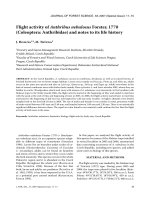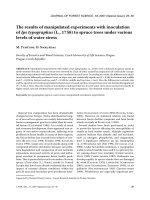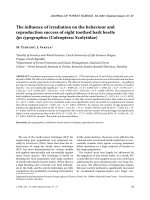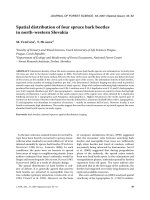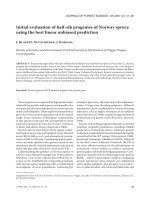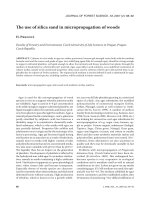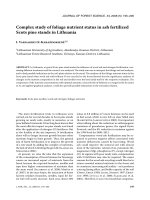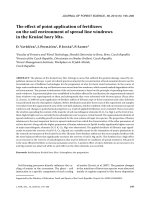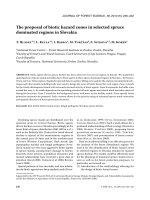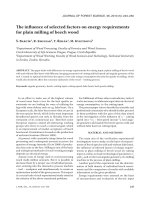Báo cáo lâm nghiệp: "Late-season fertilization of Picea mariana seedlings: intensive loading and outplanting response on greenhouse bioassays" potx
Bạn đang xem bản rút gọn của tài liệu. Xem và tải ngay bản đầy đủ của tài liệu tại đây (315.28 KB, 9 trang )
737
Ann. For. Sci. 61 (2004) 737–745
© INRA, EDP Sciences, 2005
DOI: 10.1051/forest:2004073
Original article
Late-season fertilization of Picea mariana seedlings:
intensive loading and outplanting response on greenhouse bioassays
Joseph R. BOIVIN, K. Francis SALIFU, Vic R. TIMMER*
Faculty of Forestry, University of Toronto, 33 Willcocks Street, Toronto, M5S 3B3, Canada
(Received 5 January 2004; accepted 11 May 2004)
Abstract – Traditional greenhouse culture involves a late-season hardening period that withholds irrigation and fertilization from black spruce
seedlings to promote frost-hardiness. Since nutrient uptake is limited without supplemental fertilization, growth during hardening may lead to
internal nutrient dilution, a condition detrimental to field performance of seedlings. We examine whether late-season fertilization, applied as
intensive loading, will counter dilution and build up nutrient reserves in seedlings reared conventionally or nutrient loaded before hardening. A
mixed NPK fertilizer delivering 0, 12, 24, or, 48 mg N·seedling
–1
for 9 weeks after bud set was tested. Root and shoot dry mass increased as
much as 104 and 42% during hardening. Seedling biomass, however, was unchanged by late-season fertilization, but N uptake was increased
44–167% signifying induced luxury consumption. Extra K supplementation of treatments averted K dilution in plant tissues often occurring
with high N addition. A 13-week outplanting trial on intact soil bioassays retrieved from a boreal site showed that growth and nutrient allocation
were significantly enhanced by larger N reserves built up after intensive nutrient loading. About 72–80% of N required for new shoot growth
was met from internal cycling, demonstrating the capacity of loading to enhance retranslocation. Intermediate loading (24 mg N) was most
effective in promoting N accumulation and outplanting growth of both seedling types. Survival was reduced (30%) only at the highest dose.
Study results demonstrate the potential advantage of these practices to improve growth of newly planted seedlings on northern forest sites.
black spruce / hardening period / nitrogen / nutrient loading / retranslocation / super-loading
Résumé – Fertilisation tardive de semis de Picea mariana : apport intensif et réponse après plantation en serre d’essais biologiques. Les
cultures traditionnelles en serre comportent une période tardive d’endurcissement qui retarde l’irrigation et la fertilisation des semis de Picea
mariana pour promouvoir l’endurcissement au froid. Puisque le prélèvement de nutriments est limité sans supplémentation de fertilisation, la
croissance pendant la période d’endurcissement peut conduire à une dilution interne des nutriments, une situation préjudiciable pour les
performances au champ des plants. Nous avons examiné si la fertilisation tardive, appliquée par des apports massifs peut contrebalancer la
dilution et accroître les réserves de nutriments dans les semis élevés conventionnellement ou les nutriments apportés avant l’endurcissement.
On a testé un mélange de fertilisant NPK libérant 0,12, 24 ou 48 mg d’azote par semis pendant 9 semaines après le débourrement. Le poids sec
des racines et des pousses s’est accru de 104 et 42 % pendant l’endurcissement. Cependant la biomasse des semis a été inchangée par une
fertilisation tardive, mais le prélèvement d’azote s’est accru de 44 à 167 %, indiquant une consommation de luxe. Une supplémentation en K
évite une dilution en K des tissus, ce qui arrive souvent avec un apport important d’azote. Un essai à 13 semaines sur un sol pour essais
biologiques, extrait d’une station boréale, a montré que la croissance et l’allocation des nutriments étaient significativement augmentées par de
grandes réserves d’azote accumulé après des apports intensifs de nutriments. Environ 72 à 80 % de N requis pour la croissance des nouvelles
pousses provenaient du cycle interne, démontrant l’importance des apports pour augmenter les retranslocations. Un apport intermédiaire (24 mg N)
était plus efficace pour promouvoir l’accumulation de N et la croissance des deux types de semis. La survie a été réduite (30 %) seulement pour
la plus forte dose. Les résultats de cette étude ont démontré l’avantage potentiel de ces pratiques pour l’amélioration de la croissance des semis
dans les stations forestières du Nord.
Picea mariana / période d’endurcissement / azote / apport de nutriment / retranslocation / super apport
1. INTRODUCTION
Intensive forestry in Canada involves large-scale reforesta-
tion programs that require high quality planting stock, condi-
tioned for improved survival, nutrition and vigorous growth
after outplanting. However, studies have shown that survival
and growth of newly planted conifer seedlings may be reduced
by low soil fertility or by intense plant competition [6, 20, 23].
Hence, nursery treatments that improve early plantation estab-
lishment may contribute significantly to reforestation success.
Examples of current nursery techniques that have promise for
improving field performance of seedlings are exponential fer-
tilization [16, 18, 42, 45] and nutrient loading [37, 47]. These
techniques nutritionally prepare and condition trees for the field
environment by matching nutrient supply with crop demand to
maximize nutrient reserves in seedlings prior to planting [36,
* Corresponding author:
738 J.R. Boivin et al.
48]. Superior growth of exponentially nutrient loaded seedlings
was attributed to retranslocation of stored nutrients to active
growth sinks soon after planting [24, 32, 36].
Traditional greenhouse cultural practices do not promote the
build up of nutrient reserves in seedlings because of late-season
cutback of fertilizer for hardening off purposes [4, 10, 22]. The
hardening period is defined as the time interval following apical
bud initiation when roots and shoots acquire frost hardiness
[10]. Apical bud initiation is induced artificially within two-
weeks of exposure to short-day photoperiod (8 h) once seed-
lings attain a target height [1, 5, 9]. Subsequent fertilization and
irrigation are usually reduced during hardening to induce mois-
ture and nutrient stress in cultured plants. This practice may
promote seedling drought and frost tolerance for winter storage
and subsequent outplanting [12], but may also lower plant
nutrient concentration due to reduced nutrient supply and dilu-
tion effects associated with growth response despite stress
induction [5]. For example, root dry mass increased as much
as 200% [5] and 794% [33] in black spruce (Picea mariana
[Mill.] B.S.P.) seedlings during hardening. Late-season fertili-
zation is controversial, however, since some studies suggest it
may negatively affect cold tolerance of conifer seedlings [2],
others found no effects on cold tolerance of conifer seedlings
[3], while still others report increased frost hardiness after
application [35]. There is general consensus that fall N fertili-
zation benefits subsequent field performance of newly planted
trees because of increased N concentration and contents in the
trees [19, 25, 39].
Biomass growth without sufficient fertilization during hard-
ening can severely dilute plant nutrient reserves, thus compro-
mising steady-state nutrition and nutrient loading efforts [2, 5,
28]. Steady-state nutrition is characterized by stable internal
tissue nutrient concentration over time free from nutrient stress
[17]. This state can be achieved by applying nutrients at expo-
nentially increasing addition rates that correspond more closely
with exponential growth and nutrient demand of crops during
the exponential growth phase of plants [18]. Compared to con-
stant feed fertilization used conventionally [44], this condition
conforms more closely to the natural outplanting environment
in terms of supply, flux and acquisition of soil nutrients for
newly planted seedlings [30].
We have previously demonstrated that late-season fertiliza-
tion as nutrient loading during hardening may counter nutrient
dilution and further build nutrient reserves in seedlings for
improved field performance [5]. At high rates, or extended
nutrient loading, this practice effectively induced luxury uptake
and raised seedling N concentration and other nutrient reserves
in plants [5]. However, growth dilution still occurred when
applications ended, reducing internal nutrient reserves to pre-
hardening levels since uptake could not keep up with rapid
growth. The results suggested more intensive loading at even
higher rates for longer time periods (or “super loading”) might
prolong nutrient uptake, avert growth dilution and promote
nutrient accumulation in seedlings. We also noted that plant K
uptake was reduced at higher N addition, which indicated that
intensified nutrient loading would need extra K to maintain
nutrient balance in seedlings [5, 49]. The study focused on
growth and nutritional development under nursery culture, but
did not cover subsequent outplanting performance of test seed-
lings.
This paper reports on a follow up of the previous study [5].
We test here whether application of super-loading regimes,
supplying higher dose rates with longer delivery schedules, can
enhance nutrient accumulation during the hardening period. A
second objective was to assess whether N induced K dilution
[5] could be avoided by enriching the applied fertilizer with
more K (30%). The final objective was to test effects of inten-
sified nutrient loading on outplanting performance of seedlings
using pot bioassays. The general hypothesis addressed was that
high-dose, late-season fertilization promotes seedling growth
and nutrition under greenhouse culture and outplanting envi-
ronments, such as on bioassays retrieved from the boreal forest.
2. MATERIALS AND METHODS
2.1. Plant material and pre-hardening fertility regimes
Black spruce seedlings were grown and over-wintered at a com-
mercial greenhouse (North Gro Development Ltd.) located near Kirk-
land Lake, Ontario (48° 10’ N, 88° 01’ W). Seeds were spring-sown
(April, 1999) into 40 cm
3
cavities in Styroblock trays (format 470 con-
taining 330 cavities·tray
–1
) filled with a peat:vermiculite:perlite mix-
ture (3:1:1, v/v/v). Germinated seedlings were reared under natural
day-length with internal greenhouse temperatures averaging 16: 28 °C
(daily night:day min.:max.). The crops were grown under two fertility
regimes before hardening (Tab. I). The first treatment referred to as
the conventional (C) fertilization regime (representing industry stand-
ard practice), supplied a seasonal total of 19 mg N·seedling
–1
based
on a constant feed model described in detail by [44]. The second treat-
ment, referred to as nutrient loading (NL) regime, delivered a seasonal
total of 74 mg N·seedling
–1
at exponentially increasing addition rates
Timmer et al. [44]. A commercial water-soluble fertilizer (Plant Prod-
ucts 20N-20P
2
O
5
-20K
2
O, plus microelements) was applied to both
regimes. The nutrient loaded treatment, however, was enriched with
more K (30%) to avoid possible K dilution associated with high N
addition [49]. The extra elemental K was supplied as KCl. Seedlings
were sprayed with nutrients as pre-mixed fertilizer solutions using
traveling booms with fixed nozzles and were subsequently rinsed with
water to avoid fertilizer burn. This commenced one week after germi-
nation and was carried out for 14 wk (Tab. I). Irrigation (including fer-
tilization and final rinse) was to container capacity [46, 50], which
assured that crops were returned to the same level of moisture avail-
ability among treatments.
When seedlings reached target height (16 cm, 12 weeks after germi-
nation), a two-week short-day treatment (8 h light with blackout cur-
tains) was imposed to induce terminal bud-set and stop height growth
[1]. The hardening period commenced after terminal bud set with a
return to natural day-length and a gradual lowering of greenhouse tem-
peratures (7:18 ºC daily night:day min.:max.). Seedlings were hard-
ened for 18 weeks (Tab. I) and then transferred to a cold storage facility
(–2 ºC) for over-wintering for about 5 months [11].
2.2. Late-season fertilization treatments
and the experimental design
Immediately following bud set, four late-season fertilization treat-
ments were tested within the conventionally (C) fertilized or nutrient
loaded (NL) regimes. The four treatments were: (i) an unfertilized or
control (0) simulating standard industry hardening practices, (ii) an
extended loading treatment (1×) that supplied a cumulative total of
12 mg N·seedling
–1
to avoid nutrient dilution [5], (iii) an intermediate
super-loading treatment (2×) at 24 mg N·seedling
–1
, and (iv) a high
super-loading treatment (4×) at 48 mg N·seedling
–1
. The two latter
Late nutrient loading of Picea mariana seedlings 739
treatments were expected to substantially build up nutrient reserves
in seedlings during hardening (Fig. 1). All four treatments (0, 1×, 2×
and 4×) were arranged within each of the two pre-hardening (C or NL)
regimes as a completely randomized design with three replications.
The fertilizer delivery schedules were based on a reverse exponen-
tial function that proportionately matched nutrient addition rate with
exponentially declining growth and nutrient uptake rates [18] during
hardening off [1, 5, 11, 47]. In theory, the delivery schedule would
avoid toxic accumulation of nutrients in the growing medium since
nutrient addition rate is synchronized with plant growth and nutrient
uptake rates [5, 18]. Calculation of the nutrient addition rate (r) was
based on the function:
(1)
where N
T
is the total amount of nutrients applied for t applications dur-
ing hardening. The starting dose (N
f
) is equal to the final dose applied
before hardening to avert potential nutrient stress during blackout [5].
Knowing r, the amount of fertilizer supplied for a specific application
(N
t
) was computed as:
. (2)
The same commercial fertilizer mix (enriched with extra K as KCl)
used before hardening was applied during hardening. Six (t =6)
weekly applications were scheduled, although the penultimate and
final applications were delayed by one and two weeks, respectively,
to allow adequate crop dry-down (Fig. 1). The required fertilizer
amount (adjusted for over spray) was added to a watering can and
sprayed on individual trays. Subsequently, trays were brought up to
container capacity [50] with water only. At the end of the hardening
period (week 36) seedlings were cold stored prior to outplanting.
2.3. Bioassay outplanting trial
The outplanting trial was comprised of 8 treatments: four within
each of the conventional (C) and nutrient-loaded (NL) groups as unfer-
tilized (0), extended loading (1×), intermediate super-loading (2×) and
high super-loading (4×). The test seedlings were planted on blocks of
intact soil substrates retrieved from a mature black spruce stand (FEC
site type 4; see [27]) near Cochrane, Ontario (49º 04’ N, 81º 01’ W).
The soil was a moderately drained, coarse sandy Orthic Humo-Ferric
Podzol topped by a shallow organic layer. The ground cover was dom-
inated by Pleurozium mosses. Thirty-two rectangular blocks of sub-
strate (36 × 30 cm) were cut to a depth of 15 cm without disturbing
surface vegetation and placed into plastic containers with pre-drilled
drainage holes to allow free drainage and aeration. The containers
were transported to the University of Toronto and placed on elevated
benches in heated and ventilated greenhouse. Growth conditions were:
temperature 18–25 ºC, humidity 65–85%, and an extended 18-h pho-
toperiod supplemented with sodium vapor lamps at a light intensity
of 250 µmol·s
–1
m
–2
at crop level. Seedlings were presorted to similar
size at planting to minimize confounding effects due to initial differ-
ences in pre-plant size. Each bioassay pot was a replicate of one treat-
ment. The pot was planted with nine seedlings at about 10 × 10 cm
spacing. The pots were then arranged as a completely randomized
design with four blocks as replicates. The pots were irrigated weekly
to container capacity [50], and randomly re-arranged on the bench to
reduce placement effects.
Table I. Treatment schedule for containerized black spruce seedlings during greenhouse culture and after outplanting. The two main fertiliza-
tion regimes: conventional (C) and nutrient loaded (NL) supplied cumulative totals of 19 and 74 mg N·seedling
–1
before budset. The four late-
season fertilization treatments within each of the C or NL regimes: control (0), extended loading (1×), intermediate super-loading (2×) and
high super-loading (4×) supplied cumulative totals of 0, 12, 24 and 48 mg N·seedling
–1
after bud set.
Year Week Cultural phase Treatment
Year 1
0–1 Germination Water only
1–14 Exponential growth Main fertilization
(C and NL)
14–16 Bud set Short day
18–27 Hardening Late-season fertilization
(0, 1×, 2× or 4×)
27–36 Hardening Water only
36+ Cold-storage
Year 2
0–13 Outplanting Water only
Figure 1. Late-season fertilization regimes: unfertilized (0), exten-
ded loading (1×), intermediate super-loading (2×), and high super-
loading (4×) treatments supplied cumulative totals of 0, 12, 24 and
48 mg N·seedling
–1
, respectively, as a pre-mixed N, P, and K fertili-
zer solution. Delivery was scheduled for 6 wk, but was delayed for
one and two weeks after wk 3 and 6, respectively, to allow adequate
dry down and avoid leaching after fertilization.
rt
t
i
fT
eNN
−
=
∑
=
1
rt
ft
eNN
−
=
740 J.R. Boivin et al.
2.4. Sampling and statistical analyses
Seedlings were sampled before (week 18) and after (week 36) the
hardening phase, and before and after transplanting for 13 weeks in
the bioassay pots (Tab. I). After harvest, growing media was rinsed
from roots and shoot lengths were recorded. Thereafter, seedlings
were separated into roots and shoots, oven dried at 70 °C for 48 h,
weighed, milled and composited by replicate or subsample for nutri-
tional analysis according to Timmer and Armstrong [45]. Preharden-
ing growth and nutrient responses were assessed on three subsamples
of five trees each drawn from randomly selected trays reared under
the conventional (C) or nutrient loaded (NL) regimes. Each regime
was imposed in a separate part of the greenhouse without replication;
hence results were presented as means and standard errors. Late-sea-
son fertilization responses were evaluated on a sample of five random
seedlings per tray (replication) using a one-way ANOVA testing four
treatments within each prehardening regime replicated three times. A
similar one-way ANOVA was conducted on results from the outplant-
ing trial based on the destructive sample of five trees per bioassay
before and after transplanting. In this case there were eight treatments
within the conventional (C) and nutrient loading (NL) regimes repli-
cated three times. Significant treatment means were ranked according
to Tukey’s HSD test at p < 0.05 [38].
3. RESULTS AND DISCUSSION
3.1. Pre-hardening growth and nutrition
Before late-season fertilization, pre-hardening nutrient
loading increased seedling N, P and K concentration without
changing total dry mass (Tab. II), reflecting typical luxury
uptake from extra fertilization since nutrient uptake was
enhanced without biomass increase [5, 7, 36]. This finding con-
curs with results of Salifu and Timmer [37] where induced lux-
ury consumption was associated with increased N content
(150%) in black spruce seedlings when compared to conven-
tionally cultured plants. Pre-hardening N content for respective
C and NL seedlings were 7.50 and 16.00 mg N·plant
–1
. Thus,
nutrient loading raised N content by 113%, and concentration
level as high as 2.9% dw, which is close to the target considered
optimum for nutrient loaded black spruce crops at the harden-
ing stage [5, 37]. Shoot:root biomass ratio was also increased
by nutrient loading (2.7–4.3) indicating proportionally more
carbon partitioning to shoots rather than roots presumably
because of greater nutrient availability in the growing medium
[37]. Similarly, high soil N availability lowered root:shoot bio-
mass ratios in longleaf pine (Pinus palustris Mill.) seedlings
grown under water stress [21].
3.2. Growth allocation and nutrient uptake during
hardening
After hardening off (week 36), late-season fertilization
increased biomass production by 40–59% (p < 0.3513, Tab. III)
in conventional (C) and 47–70% (p < 0.1611) in nutrient loaded
(NL) seedlings demonstrating that considerable growth
occurred during this period [5, 32], although differences were
not significant. As expected, most growth occurred in roots
(104%) as compared with shoots (42%), lowering shoot:root
ratios from 4.3 to 2.5 within the nutrient loaded regime (p <
0.0838) and from 2.7 to 1.9 within the conventional regime (p <
0.4954) (Tab. III and Fig. 2). This plastic response was pre-
sumably triggered by short-day treatments that induced bud-set
and shifted carbon allocation to roots rather than shoots [5, 29].
Increased proliferation and development of the root systems is
considered beneficial for newly planted seedlings. The carbon
shift promotes nutrient and moisture acquisition in compara-
tively less fertile field soils, especially soon after planting when
root extension is slow [6, 8].
Although total dry matter production was unaffected by late-
season fertilizer additions (Tab. III), N content was signifi-
cantly increased by 44–167% (p < 0.0001) in the NL-treated
seedlings, and by 100–312% (p < 0.0001) in the C-treated seed-
lings, demonstrating significant luxury uptake of N in both
regimes (Fig. 3). The accumulation was stimulated by higher
N rates illustrating the efficacy of supplemental fertilization at
this stage in the greenhouse rotation. Plant N concentration
ranged from 1.33–2.90 % dw before hardening and 0.93–4.36%
dw after hardening (Tabs. II and III). Evidently, growth dilu-
tion (reduced N concentration) occurred in unfertilized (0)
seedlings and N built up in fertilized (1×, 2×, 4×) seedlings in
both C and NL regimes. For instance, late-season fertilization
raised N concentration by 265% (p < 0.0001) and 61% (p <
0.0001) within C and NL regimes, respectively, when com-
pared to controls (Tab. III). Overall concentrations were higher
than those reported (maximum 2.88% dw) in our previous study
[5], apparently because of longer (6 vs. 9 wks) and (or) higher
(12 vs. 48 mg N·seedling
–1
) rates of late-season fertilization.
These trends although high, are in general agreement with
results of other studies [19, 39] where fall N fertilization benefited
seedling nutrition by increasing N concentration and contents in
plant tissues that subsequently stimulated growth during out-
planting.
Phosphorus uptake was also improved by 12–20% (p <
0.0235) within NL-regime seedlings during hardening (Fig. 3),
but not as markedly as with N. The difference probably reflects
that N is more readily incorporated into organic molecules than P,
Table II. Effects of nutrient loading on seedling dry mass, shoot:root ratio, and N, P and K concentration (% dw) before hardening. The pre-
hardening regimes: conventional and nutrient loaded treatments supplied cumulative totals of 19 and 74 mg N·seedling
–1
.
Pre-hardening
fertilization regimes
†
Plant dry mass
(mg)
Shoot/root
ratio
Nutrient concentration (% dw)
NP K
Conventional (C) 560 (33) 2.73 (0.14) 1.33 (0.02) 0.26 (0.01) 0.67 (0.01)
Nutrient loaded (NL) 550 (18) 4.33 (0.21) 2.90 (0.07) 0.37 (0.01) 0.81 (0.03)
†
Means (and standard error in parentheses) were estimated from random samples of 3 groups of 5 seedlings per tray within each of the C or NL regime
treatments at the end of pre-hardening phase.
Late nutrient loading of Picea mariana seedlings 741
and (or) that more N (20%) than P (9%) was supplied in the
fertilizer formulation [29]. Super-loading (2×, 4× rates) raised
P concentrations of conventional (C) seedlings (range 0.26–
0.32% dw) but lowered (range 0.37–0.33% dw) levels of the
nutrient loaded (NL) seedlings that were initially high (Tab. III).
The relatively low (12–20%) boost in P uptake suggests that
Figure 2. Root and shoot dry mass after late-season fertilization. Treatments as indicated in Figure 1. Bars represent one standard error of the
mean. For each plant component, bars sharing the same letter within regime are not statistically different according to Tukey’s HSD test
(α = 0.05).
Table III. Effects of late-season fertilization on seedling dry mass, shoot:root ratio, and N, P and K concentration (% dw) and associated
ANOVA. The two pre-hardening regimes: conventional (C) and nutrient loaded (NL) supplied cumulative totals of 19 and 74 mg N·seedling
–1
.
The four late-season fertilization treatments conducted within each regime were: control (0), extended loading (1×), intermediate super loa-
ding (2×) and high super loading (4×) supplying cumulative totals of 0 12, 24 and 48 mg N·seedling
–1
.
Prehardening
fertilization
Late-season
fertilization
†
Plant dry mass
(mg)
Shoot/root
ratio
Nutrient concentration (% dw)
NPK
C-regime
0 817a 2.06a 0.93d 0.21b 0.61a
1× 888a 1.90a 1.78c 0.31a 0.77a
2× 867a 2.17a 2.79b 0.32a 0.69a
4× 785a 2.32a 3.39a 0.28a 0.68a
NL-regime
0 863a 2.75a 2.71c 0.33a 0.68b
1× 818a 2.54a 3.52b 0.33a 0.69b
2× 935a 2.50a 3.86b 0.34a 0.80b
4× 926a 3.43a 4.36a 0.36a 1.40a
ANOVA p >F
C-regime 0.3513 0.4954 0.0001 0.0001 0.1639
NL-regime 0.1611 0.0838 0.0001 0.1757 0.0001
†
Late-season fertilization means (0, 1×, 2× and 4×) sharing similar letters within each regime (C or NL) are not significantly different according to
Tukey’s HSD test, p < 0.05.
742 J.R. Boivin et al.
higher P additions may be necessary for late-season fertiliza-
tion to maintain steady-state levels.
Ammonium (NH
4
+
) and potassium (K
+
) ion uptake appear
to be similar and competitive [14]. Consequently, K uptake
may decline with high N supply [16, 51] because NH
4
+
acts as
an uptake antagonist to K [15]. Increased K addition may coun-
ter this effect for conifer nursery stock [49]. This inhibitory
effect was noted in our previous study with late-season ferti-
lized black spruce [5], but was not evident here presumably
because of the higher K (30%) supplied (Fig. 3). Seedling K
uptake was unchanged by late-season fertilization in the C-
regime (p < 0.1989), but was increased (p < 0.0001) by 28%
and 121% in the 2×- and 4×-treated seedlings, respectively, of
the NL-regime (Fig. 3). As expected, K concentration was
reduced (diluted) in unfertilized (0) seedlings, but levels
remained at steady-state (undiluted) after super-loading signi-
fying that the extra high K application was adequate for late sea-
son applications (Tabs. II and III). The exception was elevated
K (1.40% dw) in the high super-loaded (4×) seedlings of the
nutrient loaded (NL) regime, which may reflect excess accu-
mulation (Tab. III).
3.3. Outplanting response
When outplanted on bioassays for a 13-week growing
period, late-season fertilization (1×, 2×, and 4× rates) increased
biomass production as much as 78% for conventional (C) and
115% for nutrient loaded (NL) (p < 0.0001) seedlings when
compared to the C-regime controls (Fig. 4a). There was no
mortality, except for some (30%) of the nutrient loaded 4×-
treated trees that were associated with the highest shoot/root
ratio (4.33) and highest N and K concentration (4.36 and 1.40%
dw) before transplanting (Tab. III). Growth response was also
sub-maximum for the surviving trees (Fig. 4a), suggesting pos-
sible moisture stress and (or) excessive nutrient accumulation.
Although pre-plant biomass of all treatments was similar (p <
0.1163) (Fig. 4a), N content differed (p < 0.0001) widely,
depending on loading intensity (Fig. 4b). Presumably the
higher reserves functioned as a crucial N source that was rap-
idly remobilized for sinks of new growth when outplanted [33,
34, 36].
Growth increases in new shoots were closely associated with
amounts of N accumulated in these shoots (Fig. 4). In contrast,
N content in old shoots declined to a common threshold range
(8–10 mg N) presumably reflecting mostly structurally bound
N [7]. The decline signified substantial N depletion, particu-
larly for loaded seedlings. Most N in new growth originates
from two main sources: internally from plant tissues and exter-
nally from the soil [33, 36]. Assuming that the old and new
shoots act as respective major source and sink for nutrients [23,
36], N content differences in old shoots before and after plant-
ing provide estimates of net N retranslocated to new growth.
The remaining N in new shoots then represent estimates of soil
derived N [24, 26, 32]. Nitrogen distribution among seedling
components in Figure 4b shows that net N retranslocation (or
net N depletion from old shoots to new growth) was associated
with higher pre-plant N reserves built up by pre-hardening
nutrient loading and late-season fertilization [25, 28, 43, 49,
51]. The depletion was most severe for nutrient loaded (NL)
rather than conventional (C) regime seedlings (max. 10 vs.
18 mg N, see Fig. 4b), exemplifying typical “opportunistic”
Figure 3. Seedling N, P, and K content after late-season fertilization. Treatments as indicated in Figure 1. Bars represent one standard error of
the mean. For each nutrient, bars sharing similar letters within regime are not statistically different according to Tukey’s HSD test (α= 0.05).
Late nutrient loading of Picea mariana seedlings 743
and “conservative” nutrient use strategies for respective loaded
and non-loaded seedlings [24]. Thus, retranslocation met about
11–40% of the N required for new growth in C-regime seed-
lings and up to 72–80% in NL-regime plants, demonstrating the
efficacy of loading to meeting sink demand for N through inter-
nal cycling [24, 36]. Isotope studies have shown black spruce
seedlings can rely entirely on N retranslocation (100%) to meet
early growth demands in [36], a capacity enhanced by nutrient
loading. Conventionally reared seedlings were more dependent
on soil derived N (as high as 77%), suggesting these plants may
be more prone to nutrient stress when planted on competitive
or poor fertility sites [24].
Although root biomass increased substantially after planting
(31–231%), N uptake (content) in roots changed relatively little
(1–28%) (Fig. 4). These responses contrast with higher N accu-
mulations in shoots, which seems to support the contention that
the expanding shoot system is the primary sink for retranslo-
cated nutrients in newly planted seedlings [7]. This allocation
pattern promotes light capture and photosynthesis (6, 13, 24, 26).
It must be kept in mind, however, that the 13-week outplanting
Figure 4. Component dry mass (a) and N content (b) of conventional (C) and nutrient loaded (NL) seedlings before and after transplanting on
intact bioassays of soil substrates retrieved from a Boreal forest site. Vertical error bars are standard errors of the mean. Late-season fertilization
means (0, 1×, 2× and 4× as in Fig. 1) sharing the same letter before or after outplanting are not statistically different according to Tukey’s HSD
test (α= 0.05).
744 J.R. Boivin et al.
period represented the summer growing season only, hence
root system N reserves may build up later in the autumn as
found by others [3, 25, 28].
3.4. Implications
The improved growth and nutritional status of the inten-
sively fertilized seedlings after planting demonstrate the poten-
tial benefit of nutrient loading and late-season fertilization
practices on early plantation performance. Accelerated out-
plant growth and enhanced nutrition is consistent with our
hypothesis and concurs with results of other studies [19, 28, 39,
40]. The increased biomass of seedlings may be partly attrib-
uted to higher photosynthetic rates associated with increased
N status [13, 41] that promote soluble protein accumulation for
carboxylation during photosynthesis. There is of course a limit
to the intensity of nutrient loading of seedlings. Our results
show that the high super-loading rate (48 mg N·seedling
–1
) is
toxic for black spruce culture, particularly when raised in rel-
atively small volume containers. Based on short term responses
so far, intermediate super-loading (24 mg N·seedling
–1
) was
most effective in stimulating nutrient accumulation in the nurs-
ery and promoting outplanting response with both conventional
and nutrient loaded seedlings.
The bioassay approach adopted in this study is considered
an effective tool for evaluating initial outplanting response of
seedlings. Other studies have noted close correspondence
between first year growth responses of nutrient loaded black
spruce seedlings under field conditions with growth on intact
soil bioassays [23, 31]. Consequently, our results may have rel-
evance to expected stock performance at plantation establishment.
A field trial in northern Ontario has shown that prehardening
nutrient loading increased tree biomass by 39% when com-
pared with non-loaded plants after two growing seasons [23].
A similar trial noted 49% more biomass after 6 years [42]; indi-
cating some persistence in the loading response probably
because of initial growth and nutritional advantages at planta-
tion establishment. These findings suggest that nutrient loading
at both the pre-hardening and hardening stage in the nursery
may contribute to shortening the time required to attain crown
closure, thus reducing competition with neighboring vegeta-
tion [19].
4. CONCLUSIONS
Super-loading regimes significantly increased N uptake,
which prevented N dilution, and consistently stimulated N
accumulation in seedlings during hardening. These results sug-
gest that nutrient loading practices can effectively be prolonged
until the end of greenhouse culture to build up greater nutrient
reserves for outplanting. The intermediate super loading (2×)
treatment was most effective in promoting nutrient storage in
plants during hardening. This treatment was also associated
with improved outplanting response and is recommended for
late-season nutrient loading of black spruce seedlings. Potas-
sium dilution was averted with high K enrichment of the ferti-
lizer mix, but extra P may be needed to maintain steady-state
uptake and avoid P imbalance under intensive super-loading.
When outplanted for a 13-week period, biomass production
increased by 115% in intermediate super loaded compared with
conventionally reared seedlings. However, higher loading
intensities may induce mortality. The improved growth
response was associated with increased retranslocation (72–
80%) of built-up nutrient reserves to sites of new growth.
Higher tissue nutrient concentration and uptake rates by loaded
seedlings may have promoted photosynthesis that improved
growth in these plants. Results show that nutrient loading dur-
ing the entire greenhouse rotation enhanced outplanting per-
formance on pot bioassays, and may contribute to the success
of reforestation efforts in Ontario.
Acknowledgments: We are sincerely thankful to Abe Aidelbaum,
Terry White, and the staff at North Gro Development Ltd. for dedi-
cated assistance and support for this study. Financial support from the
National Science and Engineering Research Council of Canada is
greatly acknowledged. We are also grateful to the anonymous referees
for constructive criticism of the manuscript.
REFERENCES
[1] Bigras F.J., D’Aoust A.L., Hardening and dehardening of shoots
and roots of containerized black spruce and white spruce seedlings
under short and long days, Can. J. For. Res. 22 (1992) 388–396.
[2] Bigras F.J., Gonzalez A., D’Aoust A.L., Herbet C., Frost hardiness,
bud phenology and growth of containerized Picea mariana see-
dlings grown at three nitrogen levels and three temperature regi-
mes, New For. 12 (1996) 243–259.
[3] Birchler T.M., Rose R., Haase D.L., Fall fertilization with N and K:
Effects on Douglas-Fir seedling quality and performance, West. J.
Applied For. 16 (2001) 71–79.
[4] Blake J., Zaerr J., Hee S., Controlled moisture stress to improve
cold hardiness morphology of Douglas-fir seedlings, For. Sci. 25
(1979) 576–582.
[5] Boivin J.R., Miller B.D., Timmer V.R., Late-season fertilization of
Picea mariana seedlings under greenhouse culture: biomass and
nutrient dynamics, Ann. For. Sci. 59 (2002) 255–264.
[6] Burdett A.N., Physiological processes in plantation establishment
and the development of specifications for forest planting stock,
Can. J. For. Res. 20 (1990) 415–427.
[7] Chapin F.S.III., Adaptation and physiological response of wild
plants to nutrient stress, in: Gabelman H.W., Loughman B.C. (Eds.),
Genetic aspects of plant mineral nutrition, Kluwer Academic
Publishers, The Netherlands, 1987, pp. 15–25.
[8] Chapin F.S.III., The ecology and economics of storage in plants,
Ann. Rev. Ecol. Syst. 21 (1990) 423–447.
[9] Colombo S.J., Bud dormancy status, frost hardiness, shoot moisture
content, and readiness of black spruce container seedlings for fro-
zen storage, J. Am. Soc. Hort. Sci. 115 (1990) 302–307.
[10] Colombo S.J., Frost hardening spruce container stock for overwin-
tering in Ontario, New For. 13 (1997) 449–467.
[11] Colombo S.J., Webb D.P., Glerum C., Frost hardiness testing: An
operational manual for use with extended greenhouse culture,
Ontario Ministry of Natural Resources, Forest Research Report
No. 110, 1984.
[12] Colombo S.J., Zhao S., Blumwald E., Frost hardiness gradients in
shoots and roots of Picea mariana seedlings, Scand. J. For. Res. 10
(1995) 32–36.
[13] Evans J.R., Photosynthesis and nitrogen relationships in leaves of
C
3
plants, Oecologia 78 (1989) 9–19.
[14] Flaig H., Mohr H., Assimilation of nitrate and ammonium by Scots
pine (Pinus sylvestris) seedling under conditions of high nitrogen
supply, Physiol. Plant. 84 (1992) 568–576.
[15] Hüttl R.F., Nutrient supply and fertilizer experiments in view of N
saturation, Plant Soil 128 (1990) 45–58.
Late nutrient loading of Picea mariana seedlings 745
[16] Imo M., Timmer V.R., Nitrogen uptake of mesquite seedlings at
conventional and exponential fertilization schedules, Soil Sci. Soc.
Am. J. 56 (1992) 927–934.
[17] Imo M., Timmer V.R., Vector diagnosis of nutrient dynamics in
mesquite seedlings, For. Sci. 43 (1997) 268–273.
[18] Ingestad T., Lund A.B., Theory and technique for steady state
mineral nutrition and growth of plants, Scand. J. For. Res. 1 (1986)
439–453.
[19] Irwin K.M., Duryea M.L., Stone E.L., Fall-applied nitrogen impro-
ves performance of 1-0 Slash pine nursery seedlings after outplan-
ting, South J. Appl. For. 22 (1998) 111–116.
[20] Jobidon R., Charette L., Bernier P.Y., Initial size and competing
vegetation effects on water stress and growth of Picea mariana
(Mill.) BSP seedlings planted in three different environments, For.
Ecol. Manage. 103 (1998) 293–305.
[21] Jose S., Merritt S., Ramsey C.L., Growth, nutrition, photosynthesis
and transpiration responses of longleaf pine seedlings to light,
water and nitrogen, For. Ecol. Manage. 180 (2003) 335–344.
[22] Landis T.D., Tinus R.W., McDonald S.E., Barnett J.P., Seedling
nutrition and irrigation, Vol. 4, The Container Tree Nursery
Manual, Agric. Handbk. 674, Washington DC, US Dept. Agric.
For. Ser., 1989.
[23] Malik V., Timmer V.R., Growth, nutrient dynamics, and interspe-
cific competition of nutrient-loaded black spruce seedlings on a
boreal mixedwood site, Can. J. For. Res. 26 (1996) 1651–1659.
[24] Malik V., Timmer V.R., Biomass partitioning and nitrogen retrans-
location in black spruce seedlings on competitive mixedwood sites:
a bioassay study, Can. J. For. Res. 28 (1998) 206–215.
[25] Margolis A.H., Waring R.H., Carbon and nitrogen allocation pat-
terns of Douglas-fir seedlings fertilized with nitrogen in autum. II.
Field performance, Can. J. For. Res. 16 (1986) 903–909.
[26] McAlister J.A., Timmer V.R., Nutrient enrichment of white spruce
seedlings during nursery culture and initial plantation establish-
ment, Tree Physiol. 18 (1998) 195–202.
[27] McCarthy T.G., Arnup R.W., Nieppola J., Merchant B.G., Taylor
K.C., Parton W.J., Field guide to forest ecosystems of northeastern
Ontario, Queen’s Printer for Ontario, NEST field guide, 1994.
[28] Millard P., Proe M.F., Nitrogen uptake, partitioning and internal
cycling in Picea sitchensis (Bong.) Carr. as influenced by nitrogen
supply, New Phytol. 125 (1993) 113–119.
[29] Miller B.D., Timmer V.R., Nutrient dynamics and carbon partitio-
ning in nutrient loaded Picea mariana [Mill.] B.S.P. seedlings
during hardening, Scand. J. For. Res. 12 (1997) 122–129.
[30] Munson A.D., Bernier P.Y., Comparing natural and planted black
spruce seedlings. II. Nutrient uptake and efficiency of use, Can. J.
For. Res. 23 (1993) 2435–2442.
[31] Munson A.D., Timmer V.R., Site-specific growth and nutrition of
planted Picea mariana in the Ontario Clay Belt. II. Effects of nitro-
gen fertilization, Can. J. For. Res. 19 (1989) 171–178.
[32] Nambiar E.K.S., Fife D.N., Growth and nutrient retranslocation in
needles of radiata pine in relation to nitrogen supply, Ann. Bot. 60
(1987) 147–156.
[33] Nambiar E.K.S., Fife D.N., Nutrient retranslocation in temperate
conifers, Tree Physiol. 9 (1991) 185–207.
[34] Proe M.F., Millard P., Relationships between nutrient supply, nitro-
gen partitioning and growth in young sitka spruce (Picea sitchen-
sis), Tree Physiol. 14 (1994) 75–88.
[35] Rikala R., Repo T., The effect of late summer fertilization on the
frost hardening of second-year Scots pine seedlings, New For. 14
(1997) 33–44.
[36] Salifu K.F., Timmer V.R., Nitrogen retranslocation response of
young Picea mariana to nitrogen-15 supply, Soil Sci. Soc. Am. J.
67 (2003) 309–317.
[37] Salifu K.F., Timmer V.R., Optimizing nitrogen loading in Picea
mariana seedlings during nursery culture, Can. J. For. Res. 33
(2003) 1287–1294.
[38] SAS Institute Inc., SAS/START user’s guide, Cary, N.Y., Vol. 8,
Version 6, 1989.
[39] South D.B., Donald D.G.M., Effect of nursery conditioning treat-
ments and fall fertilization on survival and early growth of Pinus
taeda seedlings in Alabama, USA, Can. J. For. Res. 32 (2002)
1171–1179.
[40] Sung S.S., Black C.C., Kormanik T.L., Zarnoch S.J., Kormanik
P.P., Counce P.A., Fall nitrogen fertilization and the biology of
Pinus taeda seedling development, Can. J. For. Res. 27 (1997)
1406–1412.
[41] Tan W., Hogan G.D., Limitations to net photosynthesis as affected
by nitrogen status in jack pine (Pinus banksiana Lamb.) seedlings,
J. Exp. Bot. 46 (1995) 407–413.
[42] Timmer V.R., Exponential fertilization and nutrient loading of
planting stock for vegetation control, in: Proc. 20th Annual Forest
Vegetation Management Conference, 19–21 Jan., Redding, CA,
1999, pp. 77–81.
[43] Timmer V.R., Interpretation of seedling analysis and visual symp-
toms, in: van den Driessche R. (Ed.), Mineral nutrition of conifer
seedlings, CRC Press Boca Raton, FL, USA, 1991, pp. 113–114.
[44] Timmer V.R., Aidelbaum A., Manual for exponential nutrient loa-
ding of seedlings to improve outplanting performance on competi-
tive forest sites, Nat. Res. Canada. Can. For. Ser., Sault Ste Marie,
On. NODA/NFP Tech. Rep. TR25, 1996.
[45] Timmer V.R., Armstrong G., Growth and nutrition of containerized
Pinus resinosa at exponentially increasing nutrient additions, Can.
J. For. Res. 17 (1987) 644–647.
[46] Timmer V.R., Armstrong G., Growth and nutrition of containerized
Pinus resinosa seedlings at varying moisture regimes, New For. 3
(1989) 171–180.
[47] Timmer V.R., Armstrong G., Miller B.D., Steady-state nutrient pre-
conditioning and early outplanting performance of containerized
black spruce seedlings, Can. J. For. Res. 21 (1991) 585–594.
[48] Van den Dreissche R., Late-season fertilization, mineral nutrient
reserves, and retranslocation in planted Douglas-fir (Pseudotsuga
menziesii (Mirb.) Franco) seedlings, For. Sci. 31 (1985) 485–496.
[49] Van den Dreissche R., Ponsford D., Nitrogen induced potassium
deficiency in white spruce (Picea glauca) and Engleman spruce
(Picea engelmannii) seedlings, Can. J. For. Res. 25 (1995) 1445–
1454.
[50] White J.W., Mastalerz J.W., Soil moisture as related to container
capacity, Am. Soc. Hortic. Sci. 89 (1966) 758–765.
[51] Xu X., Timmer V.R., Biomass and nutrient dynamics of Chinese fir
seedlings under conventional and exponential fertilization regimes,
Plant Soil 203 (1998) 313–322.
